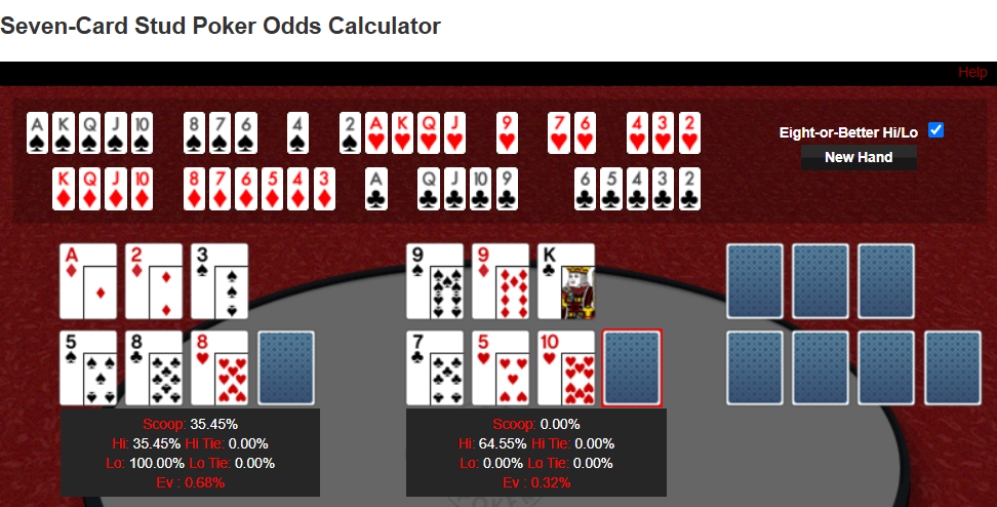WSOP 2025 Main Event Kicks Off at Horseshoe and Paris Las Vegas
03 Jul 2025
Read More
How to Play Hi-Lo Card Games (Stud 8 and Omaha 8)
- Hi-Lo games have two potential pots, split between high and low hands.
- Qualifying low hand needs five unique ranks between ace and eight.
- Aces are powerful; play aggressively with a guaranteed low hand.

(Getty Images)
- Understanding Low-Hand Games in the Poker Family: Hi-Lo
- How to Make a Low Hand in Hi-Lo Games like Omaha 8 or Stud 8
- Hi Lo Poker Games: Beginner's Tips
Understanding Low-Hand Games in the Poker Family: Hi-Lo
Looking to play more than just No Limit Hold'em? Here'are some tips and pointers on the Hi-Lo games.
No Limit Texas Hold'em is the most popular poker game in the poker family. If you asked me, I would just say it's probably because it's the simplest game.
You only get two hole cards, the betting rules are simple enough, and the hand hierarchy is straightforward.
I think it's this latter point, regarding hand hierarchies, that makes some of the other games a little more difficult for new poker players.
Mainly, I think new poker players have some trouble understanding the various "Hi-Lo" games that are out there, like Omaha Hi-Lo and Stud Hi-Lo.
These can also be called "Omaha 8" or "Stud 8." When I got bored with No Limit Texas Hold'em, at first the other games in the poker family confused me a bit.
The point of confusion was that, in these games, the pot can be split between the player with the highest hand and the player with the lowest hand. As described, at first it can sound like every hand would be split but it doesn't work that way.
New poker players should understand that "low hands" need to qualify. That's different than "high hands," which are in play for every hand.
With Omaha Hi-Lo and Stud Hi-Lo, the "high" hand hierarchy is the same as No Limit Hold'em.
It goes High Card > One Pair > Two Pair > Three-of-a-Kind > Straights > Flushes > Full-Houses > Four-of-a-Kind > Straight-Flushes (with the Royal Flush being the top straight flush).
"Low" hands are a little more difficult.
How to Make a Low Hand in Hi-Lo Games like Omaha 8 or Stud 8
To make a qualifying low hand, you need to make a hand that doesn't have a pair in it but instead has five uniquely ranked cards between ace and eight.
When it comes to evaluating the low hand, the ace is the low card. The Wheel, which is ace to five, is the lowest hand possible in Omaha Hi-Lo and Stud Hi-Lo. If you have the wheel, then you have a guaranteed stake in the low half of the pot, although it could be split if someone else also has the wheel.
Importantly, when evaluating a low hand, you do NOT count flushes or straights. Ace to five is not a straight and, even if it's all suited, it is NOT a flush.
Only the ranks of the cards matter, not whether you have a straight or flush when making the low hand. This is different than 2-7 Low Ball, where making a straight or flush means you have an extremely bad hand.
When playing Hi-Lo games, there is always a high pot. However, a low pot is NOT always in play.
In Omaha Hi-Lo, there have to be three uniquely ranked cards between ace and eight on the board for there to be a chance for someone to have a low hand.
That condition satisfied, a player would need two other low cards that don't pair the low cards on the board to make a five-card low hand. Then that would need to be the lowest hand in play to take half of the pot. We'll look at an example shortly to help clarify the matter.
The beauty of the low hand is if you have one and your opponent does not, then you can't lose the pot: if you are heads-up in the hand, then you are guaranteed a split.
That's important in Stud Hi-Lo when you can see four of the seven of your opponent's cards. There are times when you can deduce that your opponent will not make a low hand because you can see it's impossible during the draw.
Seeing your cards and seeing your own low hand (or your own probable chances of getting a low hand), you can play these hands very aggressively.
What you want in these situations is to make a low hand, guarantee yourself half of the pot, and then hope that you draw a pretty good high hand too.
For instance, if all your opponent has is two pairs, then you can hope to draw a hand that beats that for the high pot. Winning both the high pot and the low pot is called scooping. Using Stud Hi-Lo, the following hand is a potential scoop for Player 1.

In the above screenshot (Cardplayer.com), Player 2 has a pair of nines and that leads for the high hand. But Player 1 is in the better position.
He/she has clinched the low hand with A2358 (ie. no pair and five uniquely-ranked cards between ace and eight).
While Player 1 does trail for the high hand with only a pair of eights, if the luck on the river goes his way, then he/she can scoop (ie. win both the high pot and the low pot).
Player 1 can hope to improve to two-pair, three-of-a-kind, or make the Wheel. These hands would all beat a pair of nines, assuming that Player 2 does not improve.
When you have a 100% chance to win the low pot AND any kind of chance to win the high pot, then you are in a very good position.
Keeping in mind that your opponent doesn't know what your first two cards are (nor your last card), you could play aggressively and hope for a fold. In that case, you won't even need the luck of the draw to go your way on the river.
Hi Lo Poker Games: Beginner's Tips
The weak cards in Hi-Lo games are the cards between 9 and King. They do not contribute any equity to the low hand.
While they can win the high hand, you stand to be in a bad position when you end up with something decent for a high hand but can't help but wonder if your opponent has a straight or flush to go with his low hand.
If you are sitting there with Kings and Nines (ie. two pairs) and you are staring at your opponent's shown cards of 3456, you won't be able to help but wonder if one of the hidden cards is a 2 or 7 for a straight.
But even if your opponent does not have your high hand beat, you can end up nervously calling a guy down -- and your only reward ends up being half of the pot. Sometimes all you profit in those cases is half of the blinds and antes, meaning you stressed a lot over basically nothing. In other cases, you end up losing everything when your opponent's high hand does end up being something decent.
For newbies in Hi-Lo games, note that the Ace is a powerful card. It is the low card in low hands and the high card in high hands.
If you are playing tight while you learn, then it's the hands with an ace in them that are good to practice with at the low stakes. Watch and learn how it's usually the guy with the ace in his hand that's surviving and advancing.
Latest News
-
 Main Event grind
Main Event grind -
 Free eventsWin A Cash Game Buy-in With GGPoker Ontario’s Freerolls02 Jul 2025 Read More
Free eventsWin A Cash Game Buy-in With GGPoker Ontario’s Freerolls02 Jul 2025 Read More -
 Online QualifiersSummer Million Festival: Qualify via Daily Freeroll Satellites on WPT Global02 Jul 2025 Read More
Online QualifiersSummer Million Festival: Qualify via Daily Freeroll Satellites on WPT Global02 Jul 2025 Read More -
 Bad Beat JackpotStake Poker’s Cash Games Are Eligible For $1 Million Bad Beat Jackpot02 Jul 2025 Read More
Bad Beat JackpotStake Poker’s Cash Games Are Eligible For $1 Million Bad Beat Jackpot02 Jul 2025 Read More -
 WSOP cashesCanadian Cashes in WSOP 202526 Jun 2025 Read More
WSOP cashesCanadian Cashes in WSOP 202526 Jun 2025 Read More










